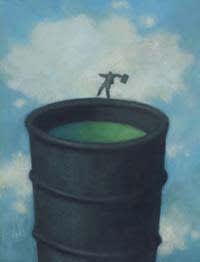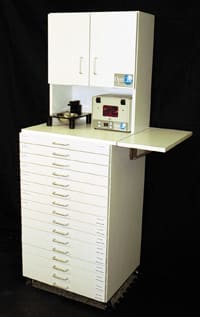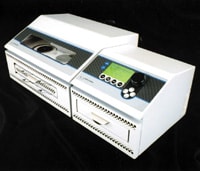Building a Case for Custom Casting
As lens technologies
continue to evolve,
competition for both
the lab's and eyecare
professional's business will heat up
By Joseph L. Bruneni
In the early days of plastic lenses, lens casting was confined solely to the manufacturing sector, even though the equipment required to cast plastic lenses was relatively inexpensive. Over time, as plastic lenses became the dominant lens material in this country, the idea of casting plastic lenses in a retail office began to look attractive to doctors and opticians. A few pennies worth of plastic could produce a valuable lens, if it was done correctly. The event that eventually made lens casting too appealing to ignore was the growing popularity of progressive lenses, certainly the most expensive lens dispensed in a retail office.

Lens casting received a lot of attention and publicity when it was announced that small retail offices could buy inexpensive equipment and make their own plastic lenses, particularly those expensive progressives. In-house casting became reality about 20 years ago, and several systems were developed for that purpose. One company took the lead in selling these clever units, but just about the time the industry concluded that retail lens casting had come of age, the dominant company shut down operations, leaving unhappy retailers behind. That seemed to spell the end of retail lens casting.
Dissatisfaction with those early systems came from inefficient casting equipment and unsatisfactory monomers. In recent years, however, viable in-office casting systems have been developed, and casting lenses in retail offices is once again a viable option.
Adding momentum to the lens casting segment of the industry has been growing interest in casting by laboratories. The first labs to become involved in lens casting in a major way were some large retail optical chain labs. Their success has created interest in lens casting for independent wholesale laboratories, as well.
Other influences are also affecting this market in some substantial ways.
|
|
|
|
The first was the development of mid-index monomers which meant that lenses cast with these systems could now be dispensed as high index lenses, increasing the potential profit per lens |
|
IMPROVED MONOMERS
Several relatively recent developments are having a positive effect on the economics of lens casting. The first was the development of mid-index monomers which meant that lenses cast with these systems could now be dispensed as high index lenses, increasing the potential profit per lens.
Another more dramatic addition was the development of photochromic monomers making it possible to cast photochromic lenses, the second most expensive lens dispensed in a retail office. These two monomer developments dramatically improved the economics of lens casting. A third development was aspheric molds, now available for some casting systems. This means another premium lens that can be produced in-house.
HIGH PRODUCTION LENS CASTING
It would seem that laboratories would be natural customers for in-house casting, but that wasn't the case until recently. Labs tend to measure lens quality against what they can produce in their lab. They will never chance selling lenses that don't match the quality of what they currently produce with conventional processing methods.
Until recently, casting systems had two strikes against them with lab owners. First, they questioned whether the lens quality could consistently equal what labs produce every day. The second issue was time. Traditional in-house casting processes were relatively slow--not a problem in a small retail office--but time becomes a real problem in a production laboratory.
|
|
|
|
NexGen Vision's casting process is totally robotic |
Both issues appear to have been overcome. New casting equipment was developed by Optical Dynamics (opticaldynamics.com) that is highly automated and works in high-production lines. Proving the concept works, some of the country's largest retail labs, owned by optical chains, have installed high-production automated casting equipment.
Another development raising interest in casting by labs came from NexGen Vision (nexgenvision.com). It has produced a totally robotic process for casting lenses in a high-production environment. Its system includes a clever process that applies in-mold scratch coating in an unusual way. As a result, when the plastic monomer polymerizes in the mold, the scratch coating becomes an integral part of the lens substrate itself.
This company also has the first brand-name photochromic monomer, making it possible for labs using its system to produce photochromic lenses carrying Corning's trade name Sunsensors®.
There is another development in lens casting that has increased lab interest in casting. One of the potential shortcomings of casting lenses in a lab is the limited range of what can be produced in a casting system. Lenses outside that range have to be produced in the traditional surfacing process. This raises a problem, particularly with progressives, since the progressive design used in the casting system would not exactly match what was available in semi-finished blanks. This was a major difficulty for labs, particularly when they were able to cast one lens but not the other.
The problem was essentially eliminated when a way was found for labs to cast semi-finished blanks in these high-production casting systems. In effect, this means the lab can produce virtually every prescription, some by casting and some by surfacing. This greatly broadens the range for lens casting.
Another sign of the times came when Essilor acknowledged that a few Essilor Labs of America are currently casting certain Varilux lenses in-house. This requires a sizable investment in equipment, however, so the number of Essilor labs that are casting is still small. For some lab people, this validated the concept of lens casting in a laboratory.
The result of all these developments is that labs are taking a fresh look at lens casting, and a number of laboratories are now casting lenses.
|
|
|
|
In-office casting systems are gaining a following, thanks to economic, quality, and inventory considerations. Below, top to bottom: Opticast's system and Optical Dynamics' Q2100R |
|
BENEFITS OF CASTING
Before looking ahead, it's important to review the reasons why people (and companies) become involved in custom casting of lenses. Those reasons are varied, but include:
Cost. The original rationale for in-office casting was economy, pure and simple. One producer of an early in-office casting system used to hang banners at every trade show stating, "Why spend dollars for progressives when you can make them for pennies?"
From the beginning of in-house lens casting, the specific target was progressive lenses simply because these are the most expensive lenses to produce in traditional ways. Casting single vision lenses didn't cut costs, and even casting bifocals was marginal in terms of savings. The original concept of custom lens casting was to produce lenses more economically.
Quality. In some ways, that's still part of the story. There are, however, mitigating factors that move the current rationale for casting lenses beyond simple cost savings. Casting companies claim that a cast-to-prescription lens is optically superior to a traditional semi-finished lens that is surfaced and polished on the back side. That belief is based on their claim that casting produces more exacting and consistent optical surfaces.
Inventory. There is a valid inventory control concept called "just-in-time" that has become popular in many industries. A just-in-time inventory system means nothing is stored at hand until shortly before it is needed for the production line. It is a difficult premise to execute, but lens casting to prescription is a prime example of how such a process can work.
With lens casting, there is no large inventory of semi-finished lens blanks, and no lens is produced until a prescription is in hand. The only inventory is a few bags of liquid monomer. Though an inventory of lens molds is required, these replace the large inventory of surfacing tools required in every surfacing lab. Labs have a growing interest in this just-in-time concept, and it might be said that "lens casting fits the mold."
Controlling inventory in this way is also attractive to lens manufacturers. The first company to set up a "cast-to-prescription" process and with "just-in-time" lens production was Rodenstock. When it acquired a company called 2C, Rodenstock took the 2C technology and refined it to develop a totally new way to produce lenses to individual prescriptions. They call their process APT.
The economies of custom lens casting have, until recently, been the primary motive for investing in the equipment (economies from casting progressives, high index, or photochromics). Now, however, manufacturers are finding another advantage from casting to prescription: Superior lenses.
Improved surfaces. Many people will agree that a cast lens enjoys certain advantages over a lens that has a cast front surface (a semi-finished blank) and a back surface ground and polished in a lab. With current technology, most multifocals and high index lenses dispensed in this country fall into this second category. Other than single vision, most lenses start out as semi-finished blanks that have factory-produced front surfaces (cast) and backside surfaces produced in a lab (ground and polished).
There certainly is nothing wrong with the quality of lenses surfaced in a lab. In fact, there have been enormous strides over the last 15 years for improving surfacing and polishing technology in labs. This includes advancements in lab equipment, polishing compounds, the tools themselves, and the polishing pads used on the tools.
A precision optics surface exam of lenses surfaced 15 years ago wouldn't begin to compare with the surface quality that labs routinely produce today. With all that said, an ideal lens would be one that has two cast surfaces, with each surface a precise replica of the mold that produced it.
Smaller size. Lens casting in a lab offers another advantage. The equipment can be scaled up or down to suit the needs of almost any size laboratory.
Opticast (opticastusa.com), a casting equipment manufacturer, is a good example of this. Its casting equipment was originally designed to meet the needs of retail offices of various sizes.
As wholesale laboratories began to show interest in casting lenses, smaller labs came to recognize the costs of investing in high-production casting equipment would be a formidable problem for a smaller volume lab.
Some of the Opticast equipment turned out to be exactly the right size for small-volume labs. The company is now actively addressing the needs of small laboratories in addition to its retail customers.
There is another technology around the corner that seems to favor lens casting. Two casting equipment companies are working on a process in which an AR coating is applied to each lens mold.
The resin is injected in the mold in the normal manner. On completion of the molding process, the lens coming out of the mold has AR coating on both surfaces.
Potentially, this will produce a superior AR coating that has become an integral part of the lens substrate itself. This possibility of in-mold AR holds great interest for laboratories.
CUSTOM CASTING'S FUTURE
As laboratories become more involved with lens casting, they are essentially becoming lens manufacturers--at least for the lenses they cast.
This might appear to be a potential conflict, but the historical relationship between labs and lens manufacturers in the United States has already changed, now that three major lens producers (Essilor, Hoya, and Sola) have set up their own lab networks.
There is also something else going on that shouldn't be overlooked. It's a potential market influence that has everyone looking over their shoulder--both labs and manufacturers alike.
As the above sidebar suggests, lens casting will not be the only technology vying for the lion's share of the business--free-form generating is a growing consideration.
There seems to be a general assumption that the way ophthalmic lenses will be produced in the future is going to be different than the way they are currently produced in labs.
With choices currently including custom lens casting or free-form generating--and the added considerations of whatever new technology develops in the coming years--labs will have to face the challenge of picking their own directions in lens production.
Though there are always plenty of questions on the horizon, at least one thing seems certain: Lens casting will continue to be a major contender and could, over time, end up as a principal process for producing prescription lenses. As Bob Dylan so aptly puts it, "The times, they are a changin'."
|
Future of Free-form? |
||||
Both labs and manufacturers seem to agree that the way ophthalmic lenses will be produced in the future may very well be different than the way they are currently produced in labs. At this point in time, it appears that the future will either be custom lens casting or a new process called "free-form generating." Labs today do, in fact, face a major dilemma in determining which technology, casting or free-form, will end up as the dominant way for labs to make lenses in the years to come. Free-form lens generation has been around for some time. It is currently used by manufacturers for producing glass molds for casting progressive lenses. Bringing this advanced type of equipment into labs is going to make it possible for labs to produce some remarkable types of lenses. Johnson & Johnson Vision Care, Inc., has set up a new division called the Spectacle Lens Group which utilizes free-form technology. It is currently manufacturing and, in test markets, distributing Definity™, an advanced progressive featuring a patented technology called Dual Add™.
The progressive curves appear on both the front and back side of the lenses. A major concern for manufacturers and labs is the fact that Johnson & Johnson will be selling these lenses direct to retailers, totally bypassing laboratories. This puts one more manufacturer into play in the battle for the eyecare professional's lens business. Also, Zeiss recently introduced a totally new progressive called Gradal Individual, which eliminates the need for standard base curve technology by combining complex optical design software with a free-form diamond surfacing technique to generate totally custom-designed lenses for the patient. This area of free-form surfacing is fast becoming a hot topic, as lens companies that include J&J, Shamir, and Zeiss have begun to introduce this progressive technology into the U.S. To help eyecare professionals better understand what this technology can mean to them and their customers, the subject of free-form generating will be examined in detail in the November issue of EB. |
||||








